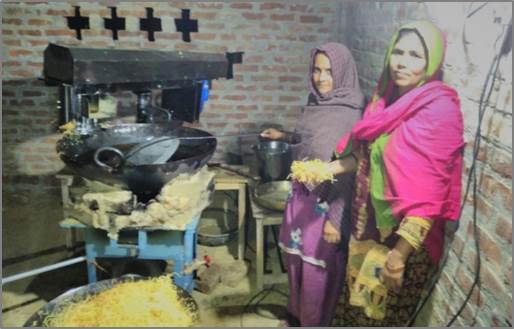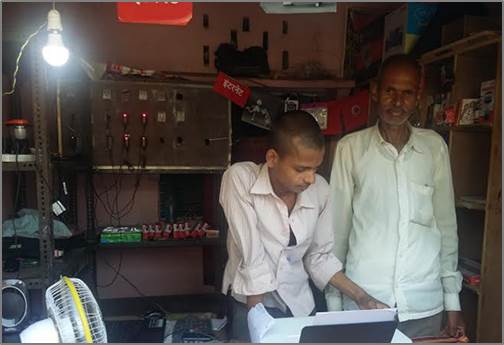|
Smart Power for Rural
Development – T oday, power generation has become one of the key indicators of economic growth and industrial development of any country. However, it contributes significantly to greenhouse gas emissions as fossil fuels such as coal have a major share in the total power generation especially in the developing countries.The power situation in India is characterised by demand in excess of supply, high Transmission and Distribution (T&D) losses, low Plant Load Factor (PLF), peak demand and energy shortages, poor financial health of the State Electricity Boards (SEBs) and severe resource crunch. Further, owing to the complexities involved, the power sector reforms in the country such as promotion of viable renewable energy technologies and the subsequent privatisation of electricity generation, T & D etc. have been rather slow 1.In the current scenario, some 400 million Indians lose electricity access during blackouts. While 80% of Indian villages have at least an electricity line, just 52.5% of rural households have access to electricity 2.The main challenge in addressing the above has been the inadequate last mile connectivity for all users. This has been despite the country’s ability to generate adequately (to exceed 99%) and have the transmission capacity to meet the full demand temporally and spatially 3. This has led to many consumers being dependent on DG (Diesel Generator) sets using costly diesel oil for meeting unavoidable power requirements. Besides, the growing aspirations of people, especially in rural areas has further added to the dependency on using DG based electricity.Smart Power for Rural Development Programme TARA (a social enterprise of the Development Alternatives Group), with support from The Rockefeller Foundation initiated a rural electrification programme in 2011 (erstwhile Smart Power for Environmentally-sound Economic Development or SPEED) with a focus on enhancing local economic development across 1000 villages of India. This programme is called – Smart Power for Rural Development (SPRD). An on-going programme, it commenced with undertaking pilot projects across villages in Uttar Pradesh and Bihar, where 20 decentralised renewable energy (Solar Photo Voltaic) plants each of 30 KW capacity were installed. Owned and managed by TARA’s energy business – TARAurja, these plants were set-up with the intention of catering load of approximately 45% to an anchor load (telecom tower), 20% to lighting (lights / fans / TV etc. for households and shops) and 35% to commercial loads (enterprises that require electricity to run businesses such as sweet shops that run freezers or electronic juicers, carpenters who use electronic planar, computer shops, mobile repairing shops that use soldering machines etc.). TARA also organised a specialised team called ‘CELAMeD’ (Community Engagement, Load Acquisition, Micro-enterprise Development) for load development activities such as mobilising the communities around the plant location, helping TARAurja to acquire loads (commercial and lighting) and for setting up new enterprises that would run on TARAurja’s electricity. It is estimated that for each site to have an optimum load utilisation, approximately 10-12 months are required to undertake CELAMeD activities. |
|
|
|
The integral components of the Smart Power for Rural Development (SPRD) include: • Tie-ups with ESCOs (Energy Service Companies), such as OMC (Omnipower Minigrids Corporation), whereby these companies were expected to bring in funds to set-up plants with subsidy from RF and CELAMeD support from TARA.• Support the development of micro enterprises in rural areas through loans, community engagement and partnerships with companies with rural footprints (TARA’s responsibility).• Build capacities of more Load Development Partners, NGO Partners (local implementation partners) and transfer know-how to ESCOs, enabling them to sustain the intervention (TARA’s responsibility).• Support policy innovations and promote platforms for networking and knowledge sharing about best practices in rural electrification.The pilot project at 20 TARAurja sites helped gain significant experiences around community engagement strategies, packaging of tariff structures for different kinds of loads (various commercial and lighting loads) and understanding around the kinds of new micro-enterprises (MEs) that can be set-up (including knowledge on the market for these new MEs). These experiences and learnings led to 60 more plants being set-up across Uttar Pradesh, with OMC as an ESCO and TARA as the load development partner. TARA’s CELAMeD team played a critical role in engaging and mobilising communities of these 60 villages and provided electricity access to over 1500 rural households / shops (mix of lighting and commercial loads across 30 locations) in a period of eight months. An overall 15-20% enhancement in income was reported for the shops that were provided electricity access (either through just lighting – which led to these enterprises running for longer hours; or enterprises that switched from unreliable grid supply to run their appliances / devices on solar based electricity; or enterprises that added a new appliance / device resulting in greater productivity, hence increased income). The programme is not just reaping environmental benefits (through use of renewable energy based electricity provision) but also social benefits (by fulfilling the basic need of access to electricity to the poor and vulnerable sections of the society) and economic benefits (by strengthening existing businesses through income enhancement and by setting up new enterprises resulting in job creation and local economy being strengthened). Today, there are over 4,500 (and counting) rural households / enterprises (existing and new) across 80+ villages in UP and Bihar, that are being supported under the programme. The current focus areas of the programme includes local economic development (strengthening existing enterprises by expanding their business and setting up new micro-enterprises), social inclusion and basic need fulfilment (women based enterprises, basic needs enterprises such as RO unit for safe drinking water), agri extension services (irrigation pumps run on solar electricity, agri-resource centres establishment – boosting agriculture in rural areas) and social marketing (generating greater awareness around benefits of renewable energy based electricity). |
|
Kumar, a TARAurja customer was a school drop-out about a year ago. TARAurja lighting connection at his father’s cloth shop encouraged him to set up his own computer shop. With a package of Rs. 350 per month (7 hours daily), he earns Rs. 6500-8000 per month, running a laptop, a printer cum scanner, mobile charging points on the TARAurja connection. |
|
Some of the key performance indicators that TARA is using for measuring its success under the SPRD programme include: • Rate at which loads are acquired. • Diversity in packages (tariff structures) that can be brought about, particularly for commercial and new micro-enterprises.• Number and kinds of tie-ups for alternate anchor loads (example: petrol pumps) and institutional loads (example: schools / banks) – at least one per site.• Local economic development – new jobs created in the village (15-20 jobs per village) and / or 20-25% enhancement in income for community members.• Number of women-based enterprises established. qSunanda Jain Endnotes 2 The Electricity Access Database – www.iea.org 3 Report: Growth of Electricity Sector in India from 1947-2015 – by Central Electricity Authority (CEA), India
|

 my own computer shop. I am no longer a good-for-nothing son, but an
earning family member. With the reliable 7 hours of electricity supply
from TARAurja, I will be expanding my business and buy connection for
more hours soon." – Dilip Kumar, Computer Shop, Nasirganj Village,
Shrawasti, UP.
my own computer shop. I am no longer a good-for-nothing son, but an
earning family member. With the reliable 7 hours of electricity supply
from TARAurja, I will be expanding my business and buy connection for
more hours soon." – Dilip Kumar, Computer Shop, Nasirganj Village,
Shrawasti, UP.